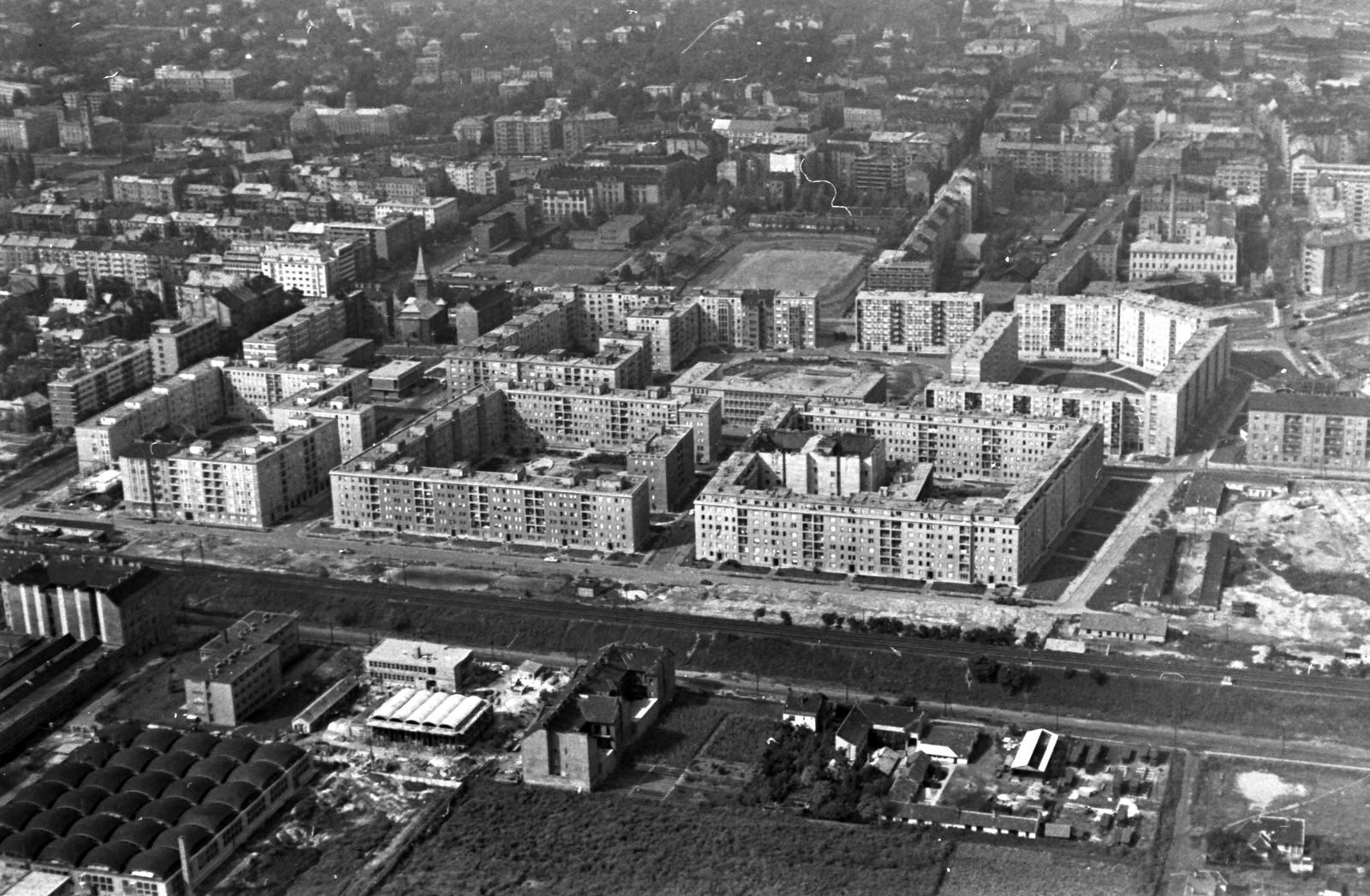In Buda, in the 11th District, the white block of the Skála store was built on the site of a former sports field. The three-story building looked like a shopping centre next to the state-owned department stores, which offered a bleak, monotonous stock in the 1970s. It also had a large car park, which made things easier for shoppers.

The site of the Skála was still a BEAC sports field in 1963 (Photo: Fortepan/No.: 26155)
The Skála also differed from the other stores in that it was not, strictly speaking, a state-owned store but a cooperative. The store was officially created by SZÖVOSZ, the National Association of Cooperatives, but in reality, it was one man's dream, that of Sándor Demján, the first director, who the management of the cooperative gave a free hand in the formation of the Skála.
What was the store like? Primarily huge – 22,500 square metres – and modern. An escalator led to each level, but from the street entrance, which opened onto the present-day October 23 Road, a moving pavement led down to the ground floor, where a huge ABC (food) store operated. This was very unusual in Hungary, as there had previously not been a similar shop.

Opening day in 1976 (Photo: Fortepan/No.: 66302)
The first floor was mostly for clothing. The second floor was more of a technical, household equipment department. The large, mostly self-service, open-plan levels were complemented by side galleries, which housed various services, including an OTP, a grill restaurant, a travel agency and a multilingual information office.
The store was built in 28 months. The opening ceremony was held on 2 April 1976. The Magyar Nemzet announced the following day:
“The largest department store in the country, the coordinating centre of the network of cooperative stores, and at the same time the imposing contribution of ÁFÉSZ and industrial cooperatives to the development of Budapest is the Skála Department Store, which was officially opened on Friday.
There are more than 30 sections in the 9 departments of the Skála, the full range of goods covers almost all the usual consumer goods in Hungary. The managers of the store were prepared for extraordinary interest after the opening ceremony. On opening day, about 800 salespeople and 101 checkouts will be working.”
An opening ceremony has held the evening before, where Károly Németh, a member of the Political Committee of the Hungarian Socialist People's Party, the secretary of the Central Committee, ceremoniously cut the inaugural ribbon.

The crowd was huge at the opening (Photo: Fortepan/Image no.: 66303)
The total store cost 600 million HUF. The new store's food department was open daily from 7 a.m. to 8 p.m., and on Saturday until 6 p.m., the other departments opened an hour later and closed an hour earlier.
What made the Skála special? The interior design evoked Viennese department stores, namely customers could wander large open spaces instead of closed departments. On the other hand, it had an extensive stock and a wide selection of goods (of course, compared to the Hungarian average at the time). At the opening, the value of the inventory was 200 million HUF, and 30 per cent of its portfolio was made by cooperatives and foreign companies, a proportion that steadily increased. Why was this important? Because the store relied on cooperatives, it was better able to offer many small-series products, which kept the inventory changing, and some products were only sold by Skála.
Anyone who remembers the usual goods of the 1970s, 1980s knows how refreshing the store was in the state-run, planned economy.

The first of its kind: Skála stores later opened in many parts of the country. The Skála of Buda in 1980 (Photo: Fortepan/No.: 66510)
How did the store work? The Budapest Socialist City Council was actively involved in the business policy of the stores. This is highlighted by an interview with Gyula Kovács, the head of the commercial department of the Budapest Socialist City Council, published in the Esti Hírlap on 29 March 1976, before the opening of the new store:
“A store alone is not enough to supply all goods. Its offering must be supplemented with that of speciality stores. We wrote to companies operating stores in the Móricz Zsigmond Circus area to adjust their product offerings to the store. They need to specialize. Anyone looking for general goods goes to the store. The speciality stores should keep different, unique, small-series goods. ”
The Skála was a huge success, and Skála stores opened around the country. But after the fall of socialism, the chain struggled to compete with the new shopping centres. The national department store chain was privatized and then merged with its former largest competitor, the formerly state-owned Centrum department stores. The company changed hands several times. The original Skála store in the 11th District operated until 2007, by which time the store had been bought by an investor who wanted to build a new, much larger shopping centre in its place. The building was demolished in 2007 and is now the Allee.
Cover photo: The Skála in 1980 (Photo: Fortepan/No.: 66511)





































Hozzászólások
Log in or register to comment!
Login Registration